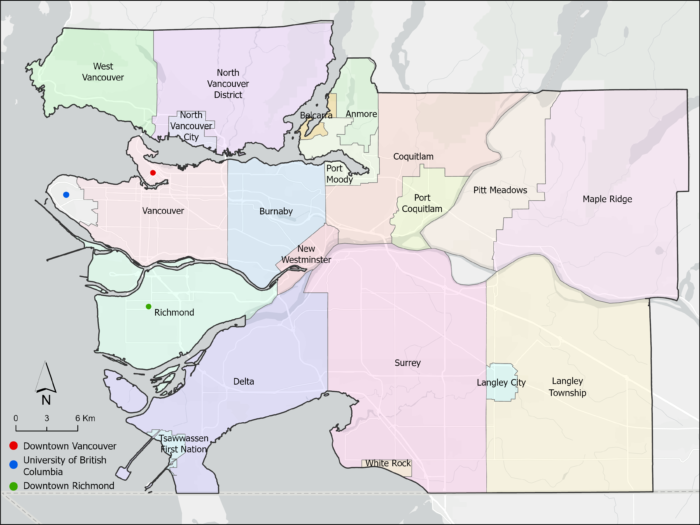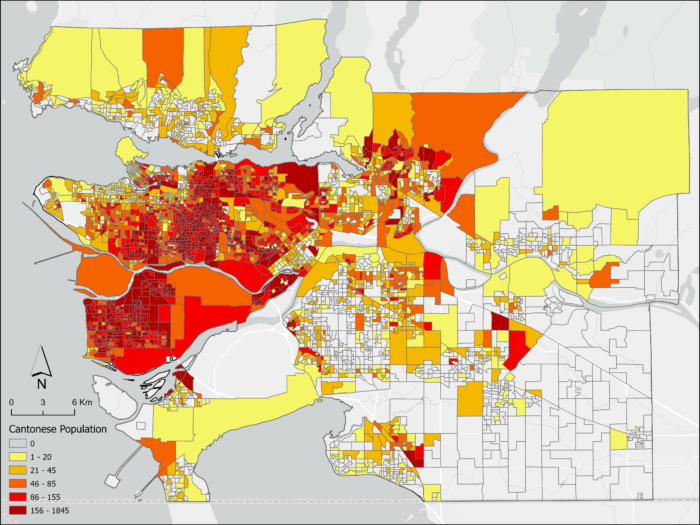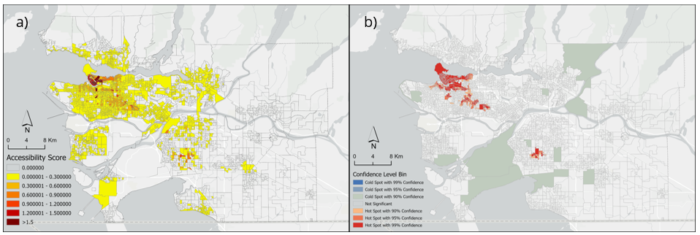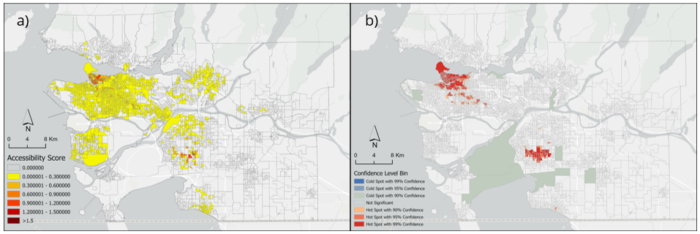Measuring Public Transit Accessibility to Cantonese-Speaking Family Physicians in Greater Vancouver
Introduction
Healthcare accessibility is a fundamental right for every population group, and it plays an important role in the health of the population (World health Organization, 2017). The recent covid-19 pandemic has demonstrated the need for spatially balanced and accessible healthcare services, as well as having equitable access for all population groups. Family physicians play a crucial role in delivering medical services across the entire spectrum of care, regardless of the patient’s demographics in Canada’s healthcare system. The country is known for its ethnocultural and religious diversity, and its long history of immigration. Many patients may face communication barriers, which has been found likely to have affect the interaction between patients and physicians (Aelbrecht et al., 2019).
This study aims to measure the public transit accessibility to Cantonese-Speaking family physicians in the Greater Vancouver Area, with the following objectives:
- Identifying hotspots and cold spots of public transit accessibility to Cantonese-Speaking family physicians
- Identify temporal variations in accessing Cantonese-Speaking family physicians

Data
Canadian Census Data 2021
- Dissemination area (DA) boundary: Dissemination Area Boundary Files (statcan.gc.ca)
- Cantonese-speaking population: Census Profile, 2021 Census of Population (statcan.gc.ca)
- Representative points: Dictionary, Census of Population, 2021 – Representative point (statcan.gc.ca)

General Transit Feed Specification (GTFS) data
- Open-sourced data that provides relevant information about the transit system
- Source: TransLink GTFS – OpenMobilityData (transitfeeds.com)
OpenStreetMap (OSM) data
- Contains detailed information and attributes about road types such as streets and highways
- Source: OpenStreetMap (Extracted using BBBike)
Cantonese-Speaking family physician information
- Retrieved from College of Physicians and Surgeons of British Columbia (CPSBC)
- Contains information such as name, registration status, language, and address
- Location of each physician are geocoded using geopy, a package in python (GeoPy Contributors, 2018).
- Source: College of Physicians and Surgeons of BC (cpsbc.ca)
Methodology
- Computing travel time matrices
- Produces a table displaying the travel time between all pairs of origin and destinations
- Calculated using r5py, a package designed for rapid realistic routing on multimodal transport networks (r5py contributors, 2023).
- Three scenarios are used: 9am (morning hour) on a weekday, 1pm (afternoon hour) on a weekday, 9am (morning hour) on a weekend
- Measuring Accessibility using the Two Step Floating Catchment Area (2SFCA) method
- Applied to measure the accessibility level of each DA to Cantonese-Speaking family physicians
- It considers of supply and demand ratio (Luo & Wang, 2003), which would be Cantonese-Speaking family physicians and immigrants in this study
- Hotspot Analysis
- First law of geography, where “everything is related to everything else, but near things are more related than distant things” (Tobler, 1970).
- Getis-Ord Gi* from ArcGIS Pro is used to identify hotspots and cold spots
- Hotspots are found when a feature with a high value is surrounded by other high value features, oppositely, cold spots are found when a feature with low value is surrounded by other low value features.
Results
The maps below show results of the 2SFCA method and hotspot analysis for the three scenarios.



High accessibility and hotspots can be found in:
- Vancouver (mainly areas near downtown)
- Surrey
- Other parts of Vancouver (weekday morning hours)
- Richmond (weekday morning hours)
Conclusion
Results indicate that public transit during morning hours on a weekday provide a higher accessibility to Cantonese-Speaking family physicians. Services on weekdays generally provide higher access when compared to the weekend.The high accessibility to Cantonese-Speaking family physicians in the areas mentioned above can be due to many reasons. The public transit and road network in downtown Vancouver is complex, and it provides high connectivity for people to travel around. In addition, the city of Vancouver has a long history of Chinese immigrants, making it well-established with Chinese-Speaking ammenities, which includes family physicians. Results have also indicate that public transit is sufficient for travelling within the city, but not for between cities.
For future research, studies related to this topic can be enhanced through implementing mixed methods such as incorporating travel diaries or questionnaires to understand and collect data on travel behaviours of the focus groups when accessing family physicians. A different model of 2SFCA, such as multi-modal or enhanced 2SFCA, should be used for more realistic measure on healthcare accessibility.
References
Aelbrecht, K., Hanssens, L., Detollenaere, J., Willems, S., Deveugele, M., & Pype, P.
(2019). Determinants of physician–patient communication: The role of language,
education and ethnicity. Patient Education and Counseling, 102(4), 776–781.
https://doi.org/10.1016/j.pec.2018.11.006
Esri. (2024). Hot Spot Analysis (Getis-Ord Gi*) (Spatial Statistics)—ArcGIS Pro |
Documentation. Retrieved March 6, 2024, from https://pro.arcgis.com/en/proapp/latest/tool-reference/spatial-statistics/hot-spot-analysis.ht
Liu, D., Lee, J., Zhong, S., & Gilliland, J. (2024). Echoes of Home: Mapping Vulnerable Places for Cantonese-Speaking Immigrants Seeking Family Doctors in the Greater Toronto Area. Health & Social Care in the Community, 2024(1), 1980874. https://doi.org/10.1155/2024/1980874
Luo, W., & Wang, F. (2003). Measures of Spatial Accessibility to Health Care in a GIS
Environment: Synthesis and a Case Study in the Chicago Region. Environment and
Planning B: Planning and Design, 30(6), 865–884. https://doi.org/10.1068/b29120
r5py Contributors. (2023). R5py – rapid realistic routing with Python. https://r5py.readthedocs.io/en/stable/
Tobler, W. R. (1970). A computer movie simulating urban growth in the Detroit
region. 46, 234–240.
World Health Organization. (2017, December 10). Health is a fundamental human right.
https://www.who.int/news-room/commentaries/detail/health-is-a-fundamentalhuman-right
